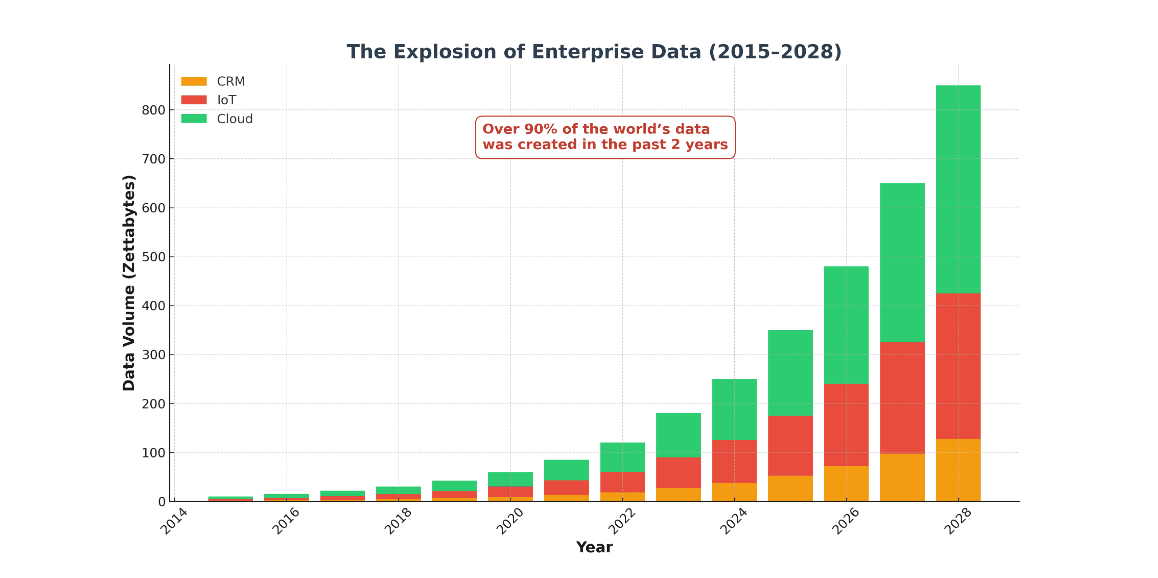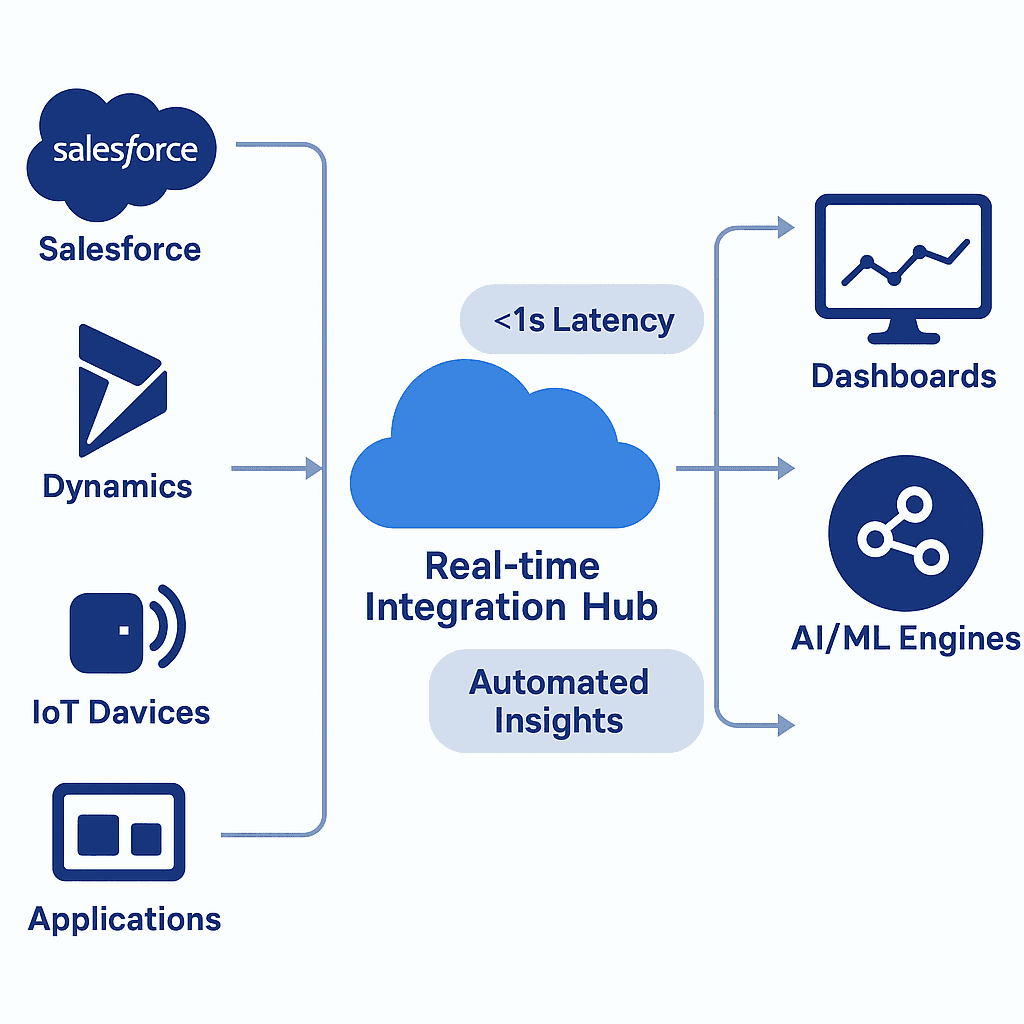Why AI Consulting for Enterprise Integration Now Requires Real-Time Data Access Across Systems
October 13
CRM Configuration
Blog

For enterprise organizations, the pace of digital transformation has shifted from measured to meteoric. As Salesforce administrators, CRM consultants, and IT leaders, you are tasked with integrating a growing ecosystem of platforms, CRM, ERP, marketing automation, IoT, legacy data warehouses, while keeping users and customers connected. With artificial intelligence (AI) now at the forefront of innovation, the greatest challenge is not just sourcing information for your algorithms, but making sure it is up-to-the-second accurate and complete. In this environment, real-time data access has become not only a technical aspiration, but a linchpin for delivering value to the entire business.

Identifying the Challenge: Legacy Integration Struggles in a Real-Time AI World
Traditional enterprise integration models relied on periodic (often nightly) data batch jobs or scheduled ETL processes. This worked when reporting and analytics requirements were basic. Today, AI-powered use cases demand much more:
- Instantaneous decision-making: AI needs continuous, up-to-date information to predict customer churn, trigger personalized offers, or detect security risks.
- Elimination of silos: When customer data, transactional data, and operational events live in separate systems, AI’s value is diminished.
- Scale and performance: The exponential growth of unstructured data from sensors, cloud platforms, and third-party APIs has made overnight refreshes insufficient for operations and compliance.
- Business risks: Relying on outdated or incomplete data leads to missed opportunities, regulatory lapses, and weaker customer engagement.
The advancement of AI and machine learning means relying on batch integration is increasingly a competitive disadvantage. According to Salesforce best practices, companies leveraging real-time connectivity can respond more quickly to market changes, personalize every customer interaction, and reduce costs.

Solution: Embracing Real-Time Data Integration for AI Consulting
Real-time data integration synchronizes customer interactions, transactions, and enterprise events as they occur—across Salesforce, Microsoft Dynamics, ERP, and custom applications. For those embarking on AI-driven digital transformations, this is the technical foundation that enables advanced analytics, hyper-personalization, and rapid response to emerging business signals.
Key components include:
- Change Data Capture (CDC): Detect and stream data changes (inserts, updates, deletions) across your CRM, ERP, and cloud sources as they happen.
- Event-driven architecture: Use triggers to activate business workflows, automations, and model retraining moments after an event occurs, reducing manual handoffs.
- Unified APIs and streaming services: Leverage tools like Salesforce Streaming API, Azure Event Hubs, and managed connectors to harmonize and distribute updates instantly.
- AI-ready data pipelines: Structure and enrich data so machine learning models can be trained, tested, and deployed on the most current information available.

Implementation Roadmap: Steps to Achieve Real-Time Enterprise Integration
Based on our decades of consulting experience, we recommend the following process for administrators and IT decision-makers:
- Inventory your data ecosystem: Document all systems (CRM, ERP, marketing, support, IoT) and data flows. Map where latency and manual updates occur.
- Define your integration and AI use cases: Prioritize goals such as improved lead scoring, next-best-action recommendations, risk management, or compliance reporting.
- Choose the right tools and partners: Partner with integration and managed services experts who bring experience with real-time architecture and have deep Salesforce and Dynamics knowledge.
- Enable change data capture and event triggers: Work with your technology team to deploy technologies that stream updates and events continuously rather than in periodic dumps.
- Monitor and optimize: Establish KPIs for latency, accuracy, and adoption. Use business intelligence dashboards to visualize the impact of real-time flows.
- Iterate and expand: Use initial wins to expand real-time integration to other departments and AI initiatives over time.

Real Benefits: What Enterprises Gain from Real-Time Access for AI
- Faster, more accurate AI: Models are trained and retrained immediately as data changes, reducing prediction drift and boosting automation value.
- Enhanced business agility: Sales, service, and ops teams act on market changes as they happen, rather than waiting hours (or days) for batch cycles.
- Improved customer experience: Marketing and service communications become truly personalized, proactive, and context-aware.
- Reduced risk and compliance overhead: Real-time auditing and alerting help catch anomalies before they propagate throughout the enterprise.
A notable example from our own client work comes from a packaging company that leveraged our integration expertise and Flowgear connectors to expose live data in Salesforce. The result was more timely reporting, custom dashboards available to all stakeholders, and a major reduction in manual data aggregation.
Best Practices and Strategic Recommendations
- Pilot and scale wisely: Start with one high-value use case (like fraud detection, cross-sell, or AI-driven ticket routing) and expand incrementally.
- Prioritize data governance: Assign data stewards, automate quality checks, and enforce access policies as data flows accelerate and touch more systems.
- Leverage expert managed services: Maintaining real-time integration over time requires maturity, trusted partners help optimize, troubleshoot, and adapt as your environment grows more complex.
As noted in Microsoft’s insights on AI-powered supply chains, the organizations achieving the greatest ROI from data and AI are those who rethink their integration strategies for speed, completeness, and scalability.
Conclusion
To maximize the value of your Salesforce, Dynamics, and broader enterprise investments, AI consulting and integration must now start with real-time access to data wherever it lives. The tools and strategies for getting there are available, but success hinges on an organized roadmap and an expert partner who helps you avoid pitfalls unique to large-scale CRM and AI projects.
With our 27+ years of CRM integration, managed services, and data transformation experience, OMI’s team can deliver secure, scalable, and effective AI and real-time solutions tailored to your environment. If you are ready to unlock actionable insights and empower every team, sales, service, marketing, and operations, to act in the present, get in touch with us today or explore our managed services.
- Salesforce: Real-Time Data Integration Best Practices
- Microsoft: Real-Time Data Integration for AI-Powered Supply Chains
Learn why real-time data access is critical for AI-driven enterprise integration and how you can transform CRM and business intelligence with modern strategies.